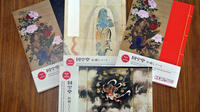Japanese Book-binding Lesson in Tokyo
Tokyo, Japan
Trip Type: Literary, Art & Music Tours
Duration: 2 hours
In central Tokyo, you can experience this traditional Japanese-style book-binding lesson to create your own notebook. Japanese book-binding, also called “Watoji,” has a 1000-year history. This special bookbinder's craft is the example of the traditional craftsmanship passed down through generations and can only be made by hand. The lesson is for all skill-levels children and adults can both participate and try their hand at the genuine Japanese craft.
More About This Activity All Literary, Art & Music Tours →
In central Tokyo, you can experience this traditional Japanese-style book-binding lesson to create your own notebook. Japanese book-binding, also called “Watoji,” has a 1000-year history. This special bookbinder's craft is the example of the traditional craftsmanship passed down through generations and can only be made by hand. The lesson is for all skill-levels children and adults can both participate and try their hand at the genuine Japanese craft.
You will experience a traditional Japanese-style book binding lesson to make your original notebook that can only be made by hand. This traditional book-binding technique has been around for 1000 years and is called “Watoji,” an example of the traditional craftsmanship passed down through generations.
The craft salon is located 10 minutes from Ikebukuro-station, one of the most major JR Yamanote-line station, by train. In a relaxed ambiance, you can make your own special notebook by the Japanese traditional binding method. All materials and equipment will be prepared for you.
Traditional “Watoji” has a 1000 year history that started from the Kamakura Period as the Japanese traditional book binding and is still made only by the hands of craftsmen even today. This handcrafted notebook is often used as the script for Japanese cultural theatre.
For making your notebook, you will use pointers, string, glue, and bodkin which you can easily get also in your country. Why is it that “Watoji” can be only made by hand? This is because that “Watoji” uses special stitching which cannot be made by a machine. This thread stitching is a picture drawn with a single stroke of the brush, which is recognized as the traditional craftsmanship passed down through generations.
Your teacher is a lecturer taught by an expert craftsman, that even the children can make their own notebook by themselves without difficulty.
In this lesson, you will use Japanese traditional craft paper called “Washi,” which is made by native Japanese materials “Kozo (Broussonetia) mitsumata plant” and ”Gampi (Diplomorpha sikokiana, a species of flowering plant).” These materials do not have added chemicals and is very slim, light and good for the natural environment. Not only is this environmentally friendly, but the notebooks are beautiful, personalized and will be a perfect memory of your trip to Japan.
You will experience a traditional Japanese-style book binding lesson to make your original notebook that can only be made by hand. This traditional book-binding technique has been around for 1000 years and is called “Watoji,” an example of the traditional craftsmanship passed down through generations.
The craft salon is located 10 minutes from Ikebukuro-station, one of the most major JR Yamanote-line station, by train. In a relaxed ambiance, you can make your own special notebook by the Japanese traditional binding method. All materials and equipment will be prepared for you.
Traditional “Watoji” has a 1000 year history that started from the Kamakura Period as the Japanese traditional book binding and is still made only by the hands of craftsmen even today. This handcrafted notebook is often used as the script for Japanese cultural theatre.
For making your notebook, you will use pointers, string, glue, and bodkin which you can easily get also in your country. Why is it that “Watoji” can be only made by hand? This is because that “Watoji” uses special stitching which cannot be made by a machine. This thread stitching is a picture drawn with a single stroke of the brush, which is recognized as the traditional craftsmanship passed down through generations.
Your teacher is a lecturer taught by an expert craftsman, that even the children can make their own notebook by themselves without difficulty.
In this lesson, you will use Japanese traditional craft paper called “Washi,” which is made by native Japanese materials “Kozo (Broussonetia) mitsumata plant” and ”Gampi (Diplomorpha sikokiana, a species of flowering plant).” These materials do not have added chemicals and is very slim, light and good for the natural environment. Not only is this environmentally friendly, but the notebooks are beautiful, personalized and will be a perfect memory of your trip to Japan.
« Go Back

